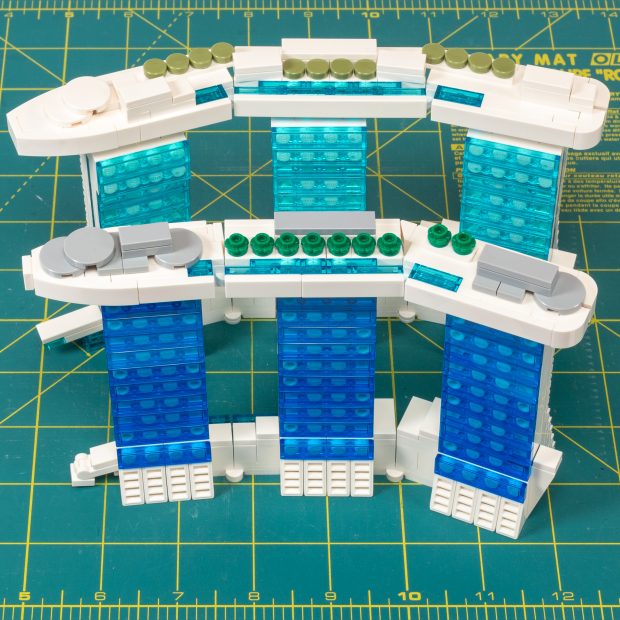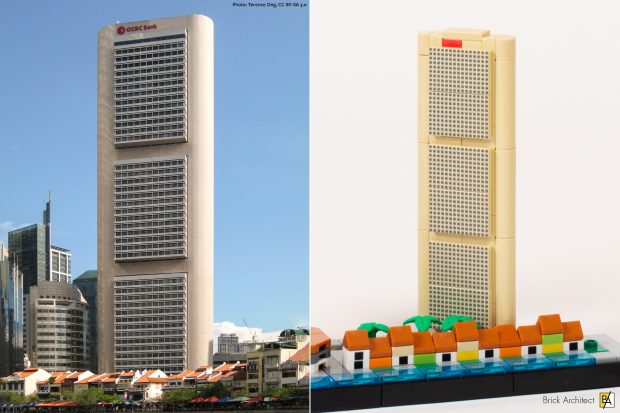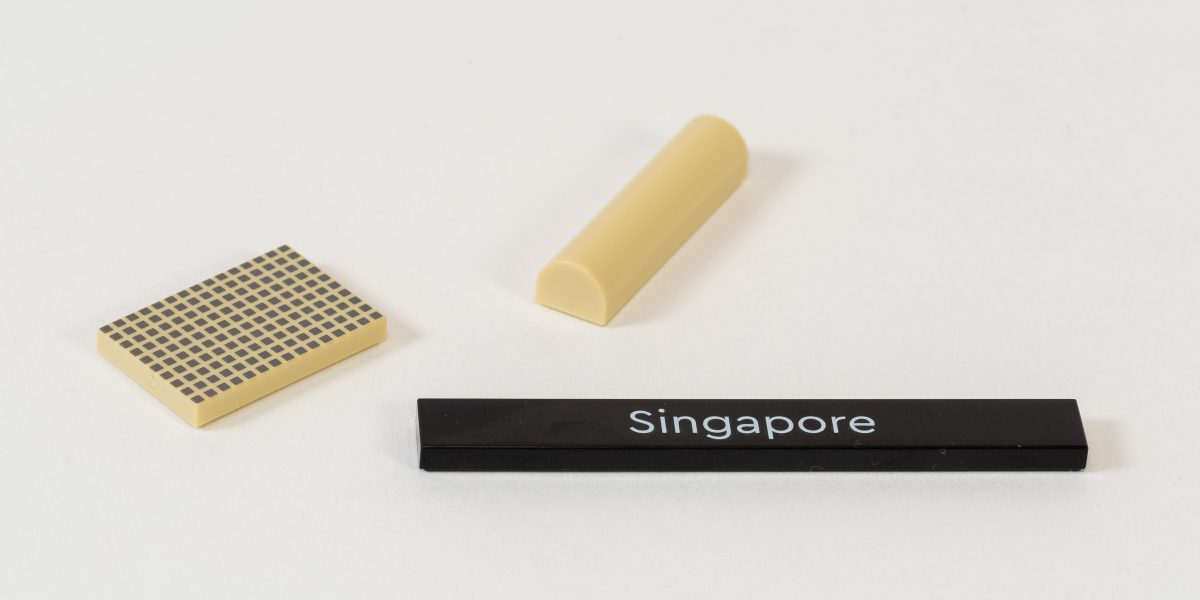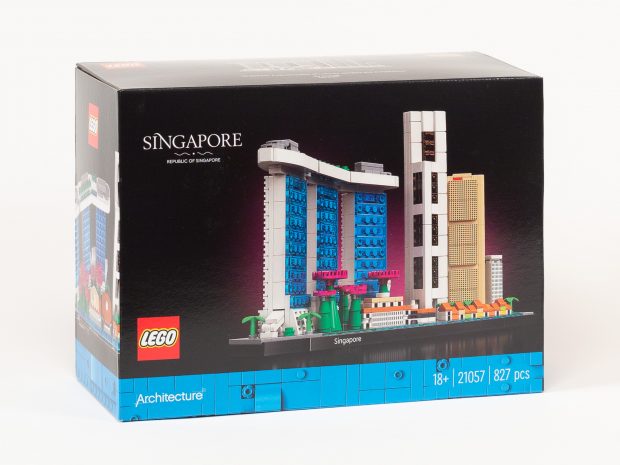Review: #21057 Singapore Skyline
The unattainable Marina Bay Sands set from 2013 is back in a complete cityscape — at 827 pieces, it’s the largest LEGO Architecture Skyline set to date (but it’s a bit kinky).
First Impressions
I was immediately surprised by a few details when the set arrived… It is the first LEGO Architecture Skyline set to feature a deeper box, and it does not include the premium box flap found in every earlier set in the series.

The box front matches the dimensions of most other skylines (like #21028 New York City), but it is about twice as thick.
It also stands out from the last two LEGO Architecture sets which introduced a contrasting white band along the bottom edge of the box (as part of the new 18+ packaging design) — for reasons I can not comprehend, the band is in a shockingly vibrant 321Dark AzurDark Azure color. I can accept the recent addition of a white band even though it didn’t feel necessary, but I strongly dislike the blue color since it distracts from the model itself and feels disingenuous to the minimalist aesthetic of the LEGO Architecture series as a whole.

The first two LEGO Architecture sets with the Adults Welcome (18+) packaging have a white stripe, but this set has a Dark Azure stripe.
As for the model itself, I noticed right away the similarity in scale and overall design between the prominent Marina Bay Sands hotel on the left, and the earlier design in the series; both involve three vertical towers that are 4-studs wide. I also recognized the Gardens by the Bay, although I did not know what it was called because I have never been to Singapore. As for the rest of the buildings, my best guess was that the small structure to the right of the Gardens would be The Raffles, because I know that it’s a historic colonial-style hotel in the heart of downtown. (The back of the box indicates it’s the nearby Fullerton Hotel.) I do not know what the three towers to the right, or the small waterfront homes are meant to represent.
I also have some concerns about how consistent the scale is across all of the buildings, since the Marina Bay Sands is very large and prominent in the model. Not to worry, we will estimate the scale of each model later in the review!
Contents
The box has unusual dimensions for a LEGO Architecture Skyline set, and doesn’t have the premium flap-style box that we’ve grown accustomed to.
- Box Size: 26 x 19 x 11.5 cm (10 ¼” × 7 ½” × 4 ½”)
- Box Weight: 692 grams (1.52 lbs)
- Box Density: 692 grams / 5.68 Liters = 121 g/L.
- LEGO Parts Weight: 411 g (0.91 lbs)
- Weight per part: 411 grams / 827 pieces = 0.50 g/piece
- Price per piece: $0.072 per piece
- Price per gram: $59.99 / 411 g = $0.146 per gram
By comparison, #31203 World Map is $0.062 per gram, and #10292 Friends – The Apartments is $0.084 per gram, and #10282 Adidas Originals Superstar is $0.109 per gram.
At well under 10 cents a piece, this looks like a good value. Unfortunately, our new analysis based on the price-per-gram shows that at $0.15 per gram, this is the worst value we’ve seen since including this in our analysis. It really does showcase how price-per-part isn’t a very good judge of value!
Box Contents:
- Stage 1: 1x large bag (marked 440H1).
- Stage 2: 1x medium (marked 440H1).
- Stage 3: 1x large bag (marked 540H1).
- Stage 4: 1x medium bag (marked 440H1).
- Stage 5: 1x large bag (marked 440H1).
- 104-page instruction booklet. 19.5 x 17.5 cm (7 3/4 x 6 7/8”)
Build Process
The build process is familiar to anyone who has built previous sets in the LEGO Architecture Skyline series… We will begin with a strong base that is three plates tall and mostly covered in smooth tiles.
Bag 1 – Base
The first bag focuses on creating an oddly-shaped base which the rest of the model will sit on. The leftmost and rightmost edges have the same 4-stud depth that’s typical of the skyline series, but it quickly dives deeper, especially on the left side. This is self explanatory from the box photo, since the iconic Marina Bay Sands is installed at an angle in the composition.
Build Time: 19 minutes.
Bag 2 – Smaller Buildings
The Marina Bay Sands dominates the front of the box, but we aren’t ready to build it yet. Instead, the second bag focuses on a selection of smaller landmarks in the model.
The rightmost building is basically a stack of four printed 1×2 bricks that is placed in the back-right corner. It is not identified by name on the box or in the instruction booklet, but research about the area using Google Maps indicates that it is probably The Riverwalk, a 103m tower located behind the Boat Quay.
Along the front edge, the Boat Quay is re-created in an abstract way using printed White 1×1 plates, plates in a selection of other colors, and Dark Orange roofs. It is very abstract and a bit too colorful, but works in capturing the essence of the place as seen in photos.
Lau Pa Sat is placed to the left of the Boat Quay. The former fish market was built in 1824, relocated in 1894, and is now used as a regional food court. Its octagonal shape is easily re-created using 2×2 Wedge Plates (part 26601) on all four sides, and covered with 2×2 Corner Tiles (part 27263). The small scale makes it a pretty rough approximation.
To the left still, we build The Fullerton Hotel, which is the first model in the set that has enough specific details that I don’t need to describe it as impressionistic, with its flanking porticos and central colonnade. The nearly triangular shape is accurate to the real building, but it’s too small and simplified to be especially faithful to the source material. I also continue to dislike the over-reliance on printed parts here.
Finally as we wrap up bag 2, we get to build the OCBC Centre, the first immediately recognizable tower in the set. As noted in the instruction booklet, the building is un-charitably nicknamed “the calculator” due to the flat shape and button-like windows.
Again, we are overly relying on a printed part to create the windows, but at least the building looks good. I also liked seeing how the clips attach at an angle to the bar elements cleverly hidden in the base.
Build time: 18 minutes.
Bag 3 – One Raffles Place
There’s nothing all that complicated about the building process, but the end result is a LEGO re-creation of a real building that’s completely recognizable and interesting to look at. The real building has a more complex form, but the primary element is the intersection of a shorter and taller triangular form that approximate a rectangle when combined.
Build time: 14 minutes.
Bags 4-5 – Marina Bay Sands & Gardens by the Bay
Let’s be honest, the Marina Bay Sands dominates this model, so it’s no surprise that the building takes multiple bags to complete. Immediately after starting bag four, I am experiencing deja-vu; the building techniques and overall form are remarkably similar to what I remember from the much earlier #21021 Marina Bay Sands (2013).
Each of the three towers are comprised of two SNOT assemblies facing to the front and back, connected to a central core that’s 1 stud thick. While it isn’t strictly necessary to hold the model together, you will find two minifigure Weapon w/ studs on both sides (part 44709) as spacers. This is a convenient part for this purpose, since the gap is the width of a stud, which is an awkward gap to fill using bricks and plates. (The width of a stud is 1½ plates thick, or half of the height of a brick.)
One quirk of the design is that the angle between the first and second module is noticeable, but the angle between the second and third module is significantly more gentle. This difference in angle stood out when analyzing the photo on the front of the box, and I’m concerned that it will negatively impact the finished model.
We weren’t quite finished with the tower as we begin bag five, so that’s where we start. After completing the last tower, we build a series of awkward modules that snap into the top to approximate the shape of the gigantic, curved patio which contains the hotel’s iconic infinity pool along the front edge.
We finish the model with an impressionistic re-creation of the Gardens by the Bay, which relies on Magenta hubcaps in two sizes to represent the flaring forms at the top of each tower.
Build time: 35 minutes. (Bag 4: 14 minutes, Bag 5: 21 minutes)
Comparison with #21021 Marina Bay Sands
As noted throughout the article, the version of Marina Bay Sands in this model bears a close likeness to the prior rendition in set #21021 Marina Bay Sands. Limited to just 10,000 copies and only sold in Asia, it sells for a premium to serious collectors ($800 for a pristine sealed copy.)
The most obvious similarity are the towers, which are the same 4-stud width with a 4-stud gap between each tower. That said, there is a very obvious difference in color, with the darker and more saturated 43Transparent BlueTrans-Dark Blue used for the newer version, and the more muted 42Transparent Light BlueTrans-Light Blue in the original.

#21021 (top) and #21052) bottom – comparing the smooth curve on the original with the banana-like kink in the newer one.
We also see a difference in height, with the newer version about 1 stud shorter. While the front and back facades use the same approach of one-plate offsets to approximate a curve, the original flares more aggressively than the new one – enhancing the curved appearance.
Lastly, we see the removal of a key detail completely in the new version. The hotel entrance is a triangular-shaped overhang on the south end of the building. This detail is captured using offset transparent light blue plates in the earlier set, but is simplified to a single white sloping piece in the new one.
The point of all of this is not to say that this rendition of the Marina Bay Sands hotel is bad, but rather to point out that it isn’t as good as the earlier attempt in a number of key ways. That being said, this version gives enough of the same experience as the older set that it’s hard to justify seeking out the original version unless you are a completionist.
Parts
As with most sets in the LEGO Architecture series, this set is not a particularly good source for new and rare parts. That said, this set includes one completely new part, and two new printed parts.
New Part:
- 6x – 1×4 Curved, double (part 79756) in 5Brick YellowTan.
New Printed Parts:
- 1x – 1×8 Tile printed with “Singapore” text (part 4162) in 26Black.
- 12x – 2×3 Tile printed with 15×10 Dark Gray rectangles (part 26603) in 5Brick YellowTan.
Geography
I understand that the Skyline series is an abstract representation of key landmarks of a city, but I do like to see how closely the buildings are arranged in the model as compared to their position in real life. This helps me relate the model back to my own explorations of a city, making it a better souvenir to celebrate your travels.

Looking from left-to-right, the landmarks in Singapore Skyline roughly follows an east-to-west pattern.
The model is more faithful to the cities geography than many sets in the Skyline series, with Marina Bay Sands being the eastmost building, and OCBC being the westmost named structure. (I’m not counting The Riverwalk since it isn’t mentioned by name on the box or in the instructions.) This roughly matches what the city would look like from the northeast side of the harbour.
The biggest outlier is the Gardens by the Bay, which are placed in front of the Marina Bay Sands in the model, but appear behind it in real life. The other confusing choice was both to include Lau Pa Sat at all, and to place it in the frontmost plane of the model (further forward than One Raffles Place), when it is clearly several blocks behind it.
Scale
I am a stickler for consistent scale in LEGO Skyline models, unless there is an intentional layering effect being employed to achieve a forced perspective effect. (I used this in my own skyline model of Pittsburgh because sports stadiums are far too large to include in a Skyline in any other way, and it is used in the bridge itself for the #21043 San Francisco set.) In this model, all of the buildings are rendered on just two planes, so I would expect all of the buildings in a given layer to be of nearly the same scale.
I was a bit worried that the scale would be way off due to the large size of the Marina Bay Sands, but the scale is pretty consistent across the whole model. This is especially true of the three skyscrapers, which all have a scale of almost exactly 1:1735 based on height. At a scale of 1:1931, the length of the Marina Bay Sands rooftop terrace is a bit shorter than it should be, but remains within the tolerances we have grown to expect when re-creating a real structure using LEGO.
| Building | Building Measurement | LEGO Model Measurement | Scale |
|---|---|---|---|
| Marina Bay Sands Hotel (Height) | 206.9 m | 11.9 cm | 1:1739 |
| Marina Bay Sands Terrace (Length) | 340 m | 17.6 cm | 1:1931 |
| Gardens by the Bay (Height) | 50 m | 3.8 cm | 1:1316 |
| The Fullerton Hotel (Height) | 36.6 m | 2.2 cm | 1:1664 |
| Lau Pa Sat (Width) | 76.2 m | 3.2 cm | 1:2382 |
| One Raffles Place (Height) | 277.8 m | 16 cm | 1:1736 |
| OCBC Centre (Height) | 197.7 m | 11.4 cm | 1:1734 |
| Boat Quay (Width) | 300 m | 8.8 cm | 1:3409 |
| The Riverwalk (Height) | 103 m | 4.8 | 1:2145 |
At a scale of 1:2382, Lau Pa Sat is significantly smaller than it should be. A width of 6-studs would have been more realistic, but there isn’t an obvious way to make an octagon of that size. (I might have suggested simply omitting it completely.) The Gardens by the Bay are slightly too tall, but this is at least partially justified by the subtle forced perspective from placing it in front of the Marina Bay Sands.
The other major outlier is the width of the Boat Quay, but I completely agree with the designer that it does not need to be exactly the right width to capture the ‘feel’ of the place. The Riverwalk tower on the far right (which isn’t mentioned by name on the box anyways) is a bit too small and fairly abstract, but forced perspective justifies the smaller scale since it is positioned in the back of the model.
It’s hard to believe that the Marina Bay Sands is really that large compared to a more typical skyscraper like One Raffles Place, but the math checks out — it’s an impressively large building!
Conclusion
On the other hand, the set does not compare very favorably to other sets in the LEGO Architecture Skyline series. Realistically, we only get three buildings with enough detail to be highly recognizable, and one of the three is overly reliant on printed tiles to achieve the desired effect. (I was similarly critical of the #21051 Tokyo Skyline, which received a terrible 2/5 star review.) I’m also a bit disappointed in this redesign of the Marina Bay Sands itself… This version is slightly smaller, slightly less detailed, and has the weird banana-like kink in the curve whereas the earlier version has a smoother curved shape.
Ultimately, I decided to balance the good and the bad, resulting in a Good (3/5 star) rating. The model is a bit too colorful for my taste, and the overall composition is a bit muddled. On the other hand, it lets a lot of builders re-create the Marina Bay Sands for a much more reasonable cost than the earlier set.





















Why is this 18+? It does not look difficult and could be a nice present for a 10 year old with architecture interest
There is no good reason for the 18+ age rating – The LEGO Group started using this a couple years ago to make certain sets feel “exclusive” to older builders. It makes sense for something like the massive 10,000 piece Eiffel Tower, but feels silly for this set.
Go ahead and give it to a kid!
As always, another great review – thanks Tom. Wondered if you had any idea why four additional purple hubcaps were supplied? Couldn’t see any hint about this in the manual …
For supply chain management reasons, certain parts are manufactured and put into a small bag with predictable numbers. If a set needs any of the parts in that pack, they get them all. Since these hubcaps are usually used in actual cars, they decided to include two types so builders can customize the look of their vehicles. It’s just not relevant in this set, so the others are “free” extras.
This all stems from the fact that LEGO pieces aren’t all that expensive to manufacture, but warehousing, inventorying and producing the actual sets is costly. Pre-packs like this reduce manufacturing costs for the majority of sets.
Other examples include:
Hope that helps explain this small mystery!
—Tom
I CANNOT believe they have changed the boxes!!!!! The new boxes are cheap and ugly looking as compared to the old ones and will look completely out of place on my bookshelves of all the other Architecture sets I own. Architecture is going down hill… first the book pages became thinner, and now the boxes are a joke. So disappointed in LEGO. I would gladly pay more for a decent book and the old style boxes. ~here is where I throw a ‘Rumplestiltskin’ fit~
Thanks ! Incredibly detailed and in depth review, + I appreciate the map of the town with buildings and of course the Marina Bay Sands comparison (I was about to order bricks to build the old version, a much better version as I can judge on photos with your comments Tom).
Great review, thank you!
I’m sure I’m not the only Architecture fan to use Rebrickable and Bricklink to synthesize a copy of 21021; it’s good to see an easier option becoming available to build the Marina Bay Sands.
Great review but like Tokyo this isn’t the Singapore I know…not enough open spaces and what with garish garden tops? And Raffles…but will buy as no other new Architecture set…unless the Fender Stratocaster counts!
Thank you so much for your detailed and perfectly written review! Totally agree with all your comments and both objective and subjective analysis!
It’s a pretty cool skyline presented well the whole idea at every single detail show the hierarchy form the simple to complex as well as complex to simple. I really love it! One thing I don’t like is that the box isn’t designed well as the architecture boxes before. I think that its bo looks like lack of some values or qualities for collectors keeping in a long time.
Really nice review, thanks a lot! Actually, I wrote review for the set, too (in German, though). It was my first review and yours have been a big model for it, since I really appreciate the detail with which you look into these skylines and their composition. I’m thus very happy to see that you highlight a lot of the things I noticed, too. We also seem to agree in our judgement of the Marina Bay Sands. I don’t like the odd curvature either and I would have liked to see a more original version than one so similar to the old set (a good example in this regard is Dubai for me, which has a Burj Khalifa totally different from the 2016 set although the scale is similar, and both work well in their own way). Although, my summary is probably more favourable than yours. I still like the MBS and also the rest of the models and while I’m not the biggest fan of too much printing either, I think the 2×3 tile is generic enough to warrant its use (and it captures the OCBC Centre really well). I also think the set really shines in its overall composition and the smaller more abstract buildings play out their strengths through the neat nanoscale scenery in the foreground.
However, one thing though. Are you sure Lay Pa Sat is 38 metres in width? Using Google Earth I measured about 72, which would make the scale of the model only half as big (and its thus a bit too small rather than too large).
Where is your review posted? I’m eager to read it. (through Google Translate, since I’m not a German speaker.)
As for the Width of Lau Pa Sat, I got the 38 meter width from this Wikipedia article: https://en.wikipedia.org/wiki/Lau_Pa_Sat – I repeated your exercise, measuring the width (diameter) using Google Maps – It shows a value of almost exactly 250 feet from corner to corner, which is double the value shown on that Wikipedia article. (I think the error on the website is that it says “diameter” but should say “radius”.)
I have updated the article accordingly. Thanks for pointing out this error!
Sincerely,
—Tom
I on the other hand used a slightly different value for the LEGO-height of the Fullerton, since I was just unsure which point Wikipedia measured exactly with their number and if the included the small top section on the roof. But yours is probably more accurate there, although the Fullerton is generally rather off in its size anyway. 😉
I posted my review on RogueBricks: https://roguebricks.de/forum/index.php?thread/3345-review-21057-singapore/ I considered providing an English version too, but the website infrastructure would have made it a bit clunky to have both.
Thank you for a great review!!